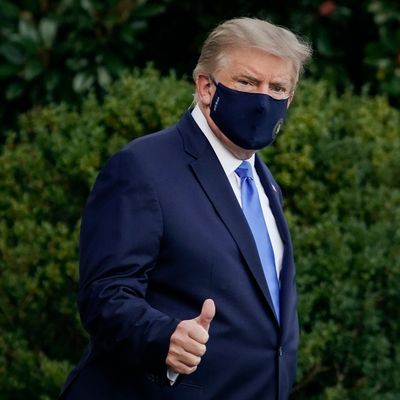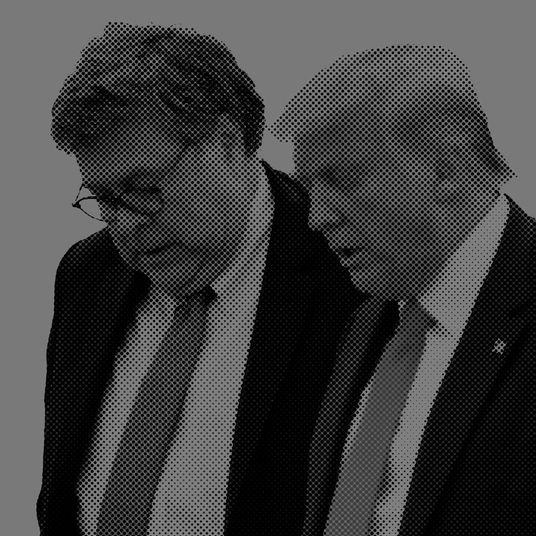
The White House is at war with the virus, with itself, and with reality — though not necessarily in that order.
With President Trump hospitalized for COVID-19 at Walter Reed medical center, officials spent the weekend sowing doubt about his condition instead of offering clarity and reassurance. Doctors and members of the White House staff provided conflicting information about the timeline and progression of the president’s illness, making a bad situation even worse. Asked what it’s been like for insiders trying to get information about the president and the virus spreading through the government, a senior White House official told Intelligencer, “That’s easy. We don’t get any.”
On Thursday, officials learned that Hope Hicks, one of the president’s closest aides, tested positive for COVID-19 just before Trump boarded Marine One en route to a fundraiser at his Bedminster, New Jersey, golf club. The White House sought to keep the story from getting out, which meant keeping much of its own staff — who, like the president, had been exposed to Hicks — in the dark. More than a dozen people connected to the White House tested positive by Saturday evening.
“Ninety percent of the [White House] complex most certainly learned about it in the news, as has been the case ever since,” the senior official said. “There are reports that COVID is spreading like wildfire through the White House. There are hundreds and hundreds of people who work on-complex, some who have families with high-risk family members. Since this whole thing started, not one email has gone out to tell employees what to do or what’s going on.”
The senior official told Intelligencer that not only is there no reliable information flow internally regarding the president’s condition, but there’s also no reliable information about anything else. Even his most senior staffers find themselves in the same predicament as those on the outside looking in. An opaque system designed to protect the White House from negative press is backfiring. “I think most of it is paranoia about leaks,” the official said, “Yet … the leaks continue.”
During Watergate, the question was, “What did the president know and when did he know it?” In 2020, the same can be asked of Trump’s infection by a virus that has killed over 200,000 people in the U.S. and over 1 million around the world — a virus that, even before it threatened Trump’s life, had threatened to define his presidency.
The answer was no clearer after 24 hours of contradictory press conferences and proclamations that concluded with White House physician Sean Conley admitting he misled the public about the president’s condition because he was trying to “reflect the upbeat attitude” of the president and his medical team.
On Saturday afternoon, Conley began dissembled with lawyerly precision. Standing in front of Walter Reed in his white coat and flanked by other doctors, Conley repeatedly dodged questions as he tried to present a rosy picture of the health of the leader of the free world. According to the White House and Conley, Trump’s stay at Walter Reed was a precaution rather than an indication that his prognosis was growing more serious.
But as he performed this delicate dance of obfuscation, Conley and his colleagues inadvertently offered a new timeline for the president’s diagnosis and treatment — suggesting that the information previously provided by the White House was false. The doctors disclosed that it had been “72 hours” since the president was diagnosed and “48 hours” since he was first given an experimental antibody therapy. That would mean he was known to be sick well before the public learned in a tweet Trump sent at 12:54 a.m Friday that he and the First Lady had tested positive. It didn’t add up.
Later, in a statement released through the White House press office, Conley insisted he misspoke when he said the president had been diagnosed “72 hours ago” and had actually meant to say “day three.” He also said he misspoke about when the experimental therapy was administered to the president: on “day two,” not “48 hours ago,” as Dr. Brian Garibaldi, a well-respected pulmonologist at Johns Hopkins hospital, had stated. Garibaldi and Johns Hopkins declined to comment.
After Conley’s press conference, the group of reporters that always accompanies the president (technically referred to as a “press pool”) was given an anonymous statement from “a source familiar with the president’s health.” The mystery source offered a fundamentally different and more grave prognosis from what the doctors had just said: “The president’s vitals over the last 24 hours were very concerning and the next 48 hours will be critical in terms of his care. We’re still not on a clear path to a full recovery.”
The source turned out to be White House chief of staff Mark Meadows. As Intelligencer first reported, cameras captured Meadows approaching reporters outside the hospital and asking to speak anonymously. “Obviously, the cameras are still rolling, so if we could go off record with some of you all and get away from the cameras,” he said. Soon after, the nameless statement undercutting the president’s doctors was emailed to the entire White House press corps. Later in the afternoon, the press reported what the doctors refused to disclose: The president had received oxygen to help him breathe.
On Sunday, Conley went into detail, telling reporters that the level of oxygen in the president’s blood had fallen before he was hospitalized. Conley admitted that he had personally administered, “at the bedside,” two liters of oxygen to the president inside the White House on Friday. Conley called the blood-oxygen drop “transient” and said the president quit using oxygen a few minutes later.
When asked why he didn’t disclose the harrowing information earlier, Conley said: “I was trying to reflect the upbeat attitude that the team, the president, that his course of illness had had.”
“I didn’t want to give any information that might steer the course of illness in another direction,” he continued, “and in doing so, it came off that we were trying to hide something that wasn’t necessarily true.” It was not immediately clear if Conley was suggesting that acknowledging the reality of the president’s sickness might make the sickness wose, which would defy common sense as well as science, or if he meant to say that providing information about the extent of the president’s symptoms could leave the public with the impression that he’s worse off than the medical team believes him to be.
Conley then claimed that Meadows’ statement about Trump’s concerning vitals was “misconstrued” by the press, and that they were always on the same page.
Though Conley said Trump’s condition is improving, he also said the president experienced a second “transient” drop in his blood-oxygen levels on Saturday and that doctors administered a steroid to him on top of a five-day course of the therapeutic drug remdesivir.
Panagis Galiastatos, a pulmonary and critical-care physician at Johns Hopkins, told Intelligencer that by administering remdesivir, Trump’s doctors are treating him like he is suffering from a “moderate” or “severe” case of COVID-19. (Physicians said Sunday they added a steroid to his treatment.) Galiastatos defined moderate as requiring hospitalization and severe as close to being committed to an intensive-care unit.
Galiastatos, who said he cared for more than 100 COVID patients in the Johns Hopkins ICU, said that his suspicion was that Trump “probably had COVID-19 around Wednesday” and that when you develop symptoms, you are “probably contagious several days before.” If this is correct, it would mean Trump could have spread the virus during Tuesday’s presidential debate, when he stood 12 feet and eight inches from Joe Biden and shouted in his direction for 90 minutes. (The Biden campaign said on Friday that Biden tested negative.)
This is the type of information the public should be learning from the president’s medical team, but it’s becoming clear that those officials cannot be trusted to be any more truthful about Trump’s condition than he is. On Saturday night, he recorded a video supposedly demonstrating his virility, during which he lied about why he was even in the hospital to begin with. He said he went “because I just didn’t want to stay in the White House” to quarantine, which meant “lock yourself in, don’t ever leave, don’t even go to the Oval Office.” The video was accompanied by photos of Trump hard at work signing blank sheets of paper.
Trump’s business career was built on what he once called “truthful hyperbole,” a salesman’s euphemism for lying. His political career was built on lies with greater consequence, like “birtherism,” the racist conspiracy that Barack Obama wasn’t born in America. His presidency began on day one with press secretary Sean Spicer lying about the size of the crowd at the inauguration.
At the end of Trump’s first term in office, the dilemma now is whether this White House can be trusted at all when it comes to the president’s personal struggle with the virus he’s been spreading misinformation about for the past nine months, providing Pollyannaish rhetoric as the cases and the deaths have mounted.
One month before Election Day, the country struggles to find reliable information about whether the president is even healthy enough to be reelected or fully capable of running the government. Intelligencer asked the senior White House official how the country could trust others serving in the White House to be truthful about the status of their own health when carelessness and secrecy have so far been the COVID status quo.
The senior White House official said, “I can’t.”
This story has been updated with additional reporting.





























